Kizu River Area Mie Pref., Nara Pref., and Kyoto Pref.

Kizu River Area
Nara City with the large Buddha, old temples, and shrines is well-known as a world-famous sightseeing spot. Also it has as a highland called
Yamato highland in the east side of the city. There are some dams there, which are important sources of water in Nara Prefecture.
Nunome Dam is one of them, which attracts tourists as well as
Nara City. This time we would like to introduce the hidden tourist spot, "
Yamazoe Village".
Nunome Dam
Nunome Dam and its reservoir lie on both sides
Nara City and Yamazoe Village. The dam seems to be a concrete gravity dam, however it has a rock-fill dam as well on the right bank side, so it should be categorized as a composite dam, to be precise.
Its reservoir is known as a fishing spot in Nara, so is always crowded with many anglers. While the dam was being constructed,
ruins of the Jomon Period (Time in Japanese prehistory, traditionally dated between 14,000B.C.–300B.C.) were discovered, and then it was named
the Koshigoe Uchikatabiro ruins. Also there are some other historic spots of several different ages around the dam, including the megalith (
Ushigamine Iwaoya Masugata) into which Nyoraizou Buddha statue was carved by Kobo Daishi(founder of a sect of Buddhism).
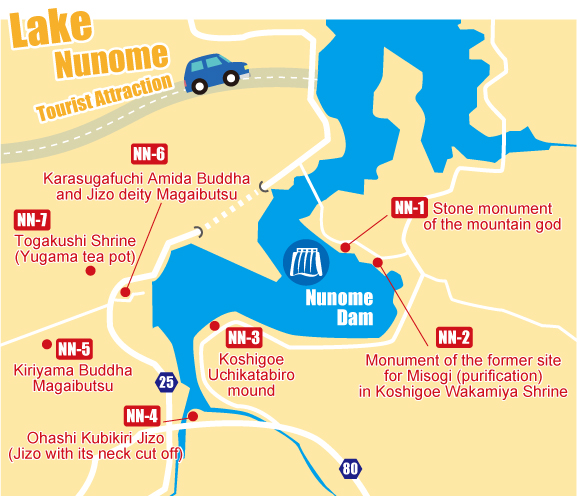
[NN-1]Stone monument of the mountain god
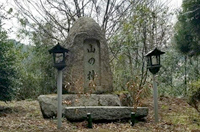 In the past the boundary between rice fields and mountains were considered as the boundary between the Buddhist life and secular world. A stone made monument stands there as the remnant of the time that people used the place for holding a festival.
In the past the boundary between rice fields and mountains were considered as the boundary between the Buddhist life and secular world. A stone made monument stands there as the remnant of the time that people used the place for holding a festival.
[NN-2]Monument of the former site for Misogi (purification) in Koshigoe Wakamiya Shrine
"Misogi" a Japanese Shinto practice of ritual purification by washing the entire body under waterfall. People purified themselves when they prayed or at a festival in the shrine a long time ago.
[NN-3]Koshigoe Uchikatabiro mound
Remains were discovered during a dam construction project. Before sinking under the dam, they were located around the center of the rice fields. A survey revealed that there was a trace of village in the early Jomon period(between around 14,000B.C.–300B.C.)
[NN-4]Ohashi Kubikiri Jizo (Jizo with its neck cut off)
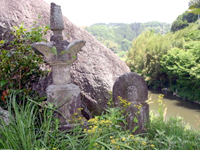 The Jizo deity statue is a 58cm tall artwork, built in the Edo period for praying traffic safety.
The Jizo deity statue is a 58cm tall artwork, built in the Edo period for praying traffic safety.
[NN-5]Kiriyama Buddha Magaibutsu
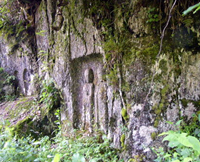 Magaibutsu made in 1566 (in the ninth year of Eiroku, the Japanese traditional name of period). It has ten objects including Jizo deity and Amida's twin rock Buddha.
Magaibutsu made in 1566 (in the ninth year of Eiroku, the Japanese traditional name of period). It has ten objects including Jizo deity and Amida's twin rock Buddha.
[NN-6]Karasugafuchi Amida Buddha and Jizo deity Magaibutsu
Magasibutsu is a Buddha carved on a rock face. You can see the Amida Buddha and Jizo deity carved on a huge rock face. It is utterly unique and unparalleled. The name of the period of its building and the name of the Buddhist are engraved.
[NN-7]Togakushi Shrine (Yugama tea pot)
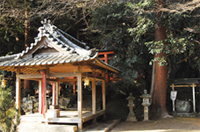 Amano Tajikarao no Mikoto, a Japanese deity who appears in Japanese mythology, is enshrined, whose name is inscribed on the tea pot.
Amano Tajikarao no Mikoto, a Japanese deity who appears in Japanese mythology, is enshrined, whose name is inscribed on the tea pot.
Gourmet spot around the Nunome Dam reservoir "Dam curry and rice with local vegetables"
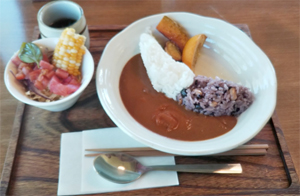
A coffee shop, "
Blan port", operated by an NPO is located in Kiriyama District, in the upstream area of the dam reservoir. "
The Nunome Dam curry and rice" inspired by the dam is a must at the shop. In fact, the dam curry is off-menu item. It has two kinds of rice. One is white rice which hints a gravity type concrete dam, and the other one does a rock fill dam with five grain rice. In addition, the curry comes with salad of seasonal vegetables. They are grown in Yamazoe Village, which is so fresh and delicious.
Highlight of Yamazoe Village
There are lots of good but unknown sightseeing spots in Yamazoe Village. Among them, Mt. Kounoyama is something you should not miss. It is the tallest mountain around the area, still you can reach the top of the mountain by car, where you can enjoy a great landscape thoroughly. Each season provides you with each seasonal view, such as Azalea in spring, or snow landscape in winter.
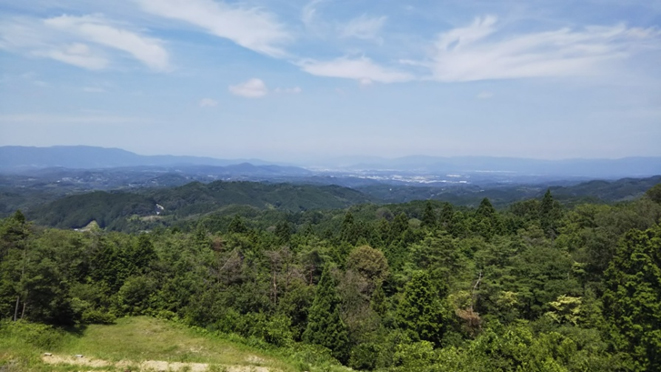
Photo: The view from the top of Mt. Konoyama. Iga city known as "
Villages of Ninja" can be seen from here.
[Y-1]Nabekura Kei (Valley)Yamazoe Village, Nara Pref.
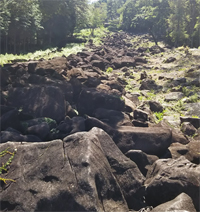 In Nabekurakei kei (Nabekura mountain river) near the summit of Mt. Konoyama, there are large and small rocks lying along it about 650m in length, which looks like a river. It is really a natural creation. How was the unique landscape made? Hints are "Gabbro" and "Granite".
In Nabekurakei kei (Nabekura mountain river) near the summit of Mt. Konoyama, there are large and small rocks lying along it about 650m in length, which looks like a river. It is really a natural creation. How was the unique landscape made? Hints are "Gabbro" and "Granite".
[Y-2]Me Me FarmYamazoe Village, Nara Pref.
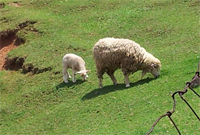 You can see the two types of sheep. One is Suffolk sheep which has black face, the other one is Corriedale sheep whose whole body is pure white. Sheep Rice crackers for the sheep are sold and you can hand-feed to them.
You can see the two types of sheep. One is Suffolk sheep which has black face, the other one is Corriedale sheep whose whole body is pure white. Sheep Rice crackers for the sheep are sold and you can hand-feed to them.
※All the contents of this brochure are based on the information available at the time of interview and data collection and they may change later.
 In the past the boundary between rice fields and mountains were considered as the boundary between the Buddhist life and secular world. A stone made monument stands there as the remnant of the time that people used the place for holding a festival.
In the past the boundary between rice fields and mountains were considered as the boundary between the Buddhist life and secular world. A stone made monument stands there as the remnant of the time that people used the place for holding a festival.
 Sitemap
Sitemap
 Kizu River Area
Kizu River Area

 The Jizo deity statue is a 58cm tall artwork, built in
The Jizo deity statue is a 58cm tall artwork, built in  Magaibutsu made in 1566 (in the ninth year of Eiroku, the Japanese traditional name of period). It has ten objects including Jizo deity and Amida's twin rock Buddha.
Magaibutsu made in 1566 (in the ninth year of Eiroku, the Japanese traditional name of period). It has ten objects including Jizo deity and Amida's twin rock Buddha.
 Amano Tajikarao no Mikoto, a Japanese deity who appears in Japanese mythology, is enshrined, whose name is inscribed on the tea pot.
Amano Tajikarao no Mikoto, a Japanese deity who appears in Japanese mythology, is enshrined, whose name is inscribed on the tea pot.
 A coffee shop, "
A coffee shop, "
 In Nabekurakei kei (Nabekura mountain river) near the summit of Mt. Konoyama, there are
In Nabekurakei kei (Nabekura mountain river) near the summit of Mt. Konoyama, there are  You can see the two types of sheep. One is
You can see the two types of sheep. One is 